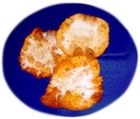|
Afghan Dessert Elephant Ear Pastries An ear for an ear? These oval shaped cookies (in the shape of an ear) are deep-fried then sprinkled with powdered sugar and pistachios.
Batter: In a large mixing bowl, beat eggs with sugar and salt till light and frothy. Add milk and oil and continue beating. Add 1 C of flour to egg mixture, blending thoroughly. Then blend 1 C more of the remaining flour, reserving 1/2 C. Dough: Turn the dough onto a floured board (using a bit of remaining 1/2 C), sprinkle the dough with more of the remaining flour and knead for 10 minutes, using flour when needed. Dough will be somewhat sticky, but have a smooth gloss to it. Cover with plastic wrap and let it rest 2 hours. Assemble & Fry: After 2 hours, pull off a piece of dough about the size of a large cherry tomato. Roll into a flat 3 1/2" x 4" oval. Take one side of the oval and fold it over to the other side, crimping edges together. It will resemble an elephant ear. Make more “ears,” deep frying them, in batches, in 350-degree oil. Turn to cook evenly till golden, remove, and drain on paper towels. Serve: When cool sprinkle with confectioner's sugar and nuts. Serve immediately or store in an airtight container. |
Tips & Glossary Afghan food is similar to the Middle East's and India's, using use many of the same spices. But Afghan cuisine is milder and lighter than its Indian cousin. Many of the ingredients used in Afghan dishes probably aren’t in your spice shelf, but you'll find them at Asian or Mid-Eastern shops. • Deep Frying: be sure oil is hot; otherwise food will be soggy and greasy. Use a deep-fry thermometer to achieve the called-for temperature. When cool, oil can be strained, refrigerated, and re-used. • Basmati Rice: literally “Queen of fragrance." This rice, cultivated in India, is known for its delicate flavor and fragrance. • Besan: also known as “gram flour,” made of ground chana dal, like chickpeas, only smaller and lighter in color. • Cardamom: related to the ginger family. Pods (green, brown, or black) are the best way to store cardamom. But high-quality ground is also available. A rule of thumb: 10 pods = 1 1/2 tsp. ground. • Coriander: aka cilantro, Chinese, or Mexican parsley. Both fresh leaves and dried ground seeds are used in Afghan, Mid-East, Asian, Indian, and Mexican cuisines. • Garam Masala: literally, “hot spice,” usually a mixture of cinnamon, cumin, cloves, nutmeg, and green cardamom seed or black cardamom pods. Because it loses its flavor quickly try to buy it with whole spices and grind it when you need it. • Ghee: clarified butter. Melt 1 lb. unsalted butter over low heat for 20 minutes (careful not to burn), remove from heat and skim away solids. Strain through cheesecloth into a separate container and keep…forever. It doesn’t need to be refrigerated. If you buy commercial ghee, make sure it comes from real butter, not hydrogenated oils. • Rosewater: distilled from rose petals and used to flavor Mid-Eastern and Asian cooking. You can make your own—but why? Buy it. • Turmeric: a deep yellow ground spice, member of the ginger family, used in curries. It has a marvelous earthy, peppery flavor.
|
Site by BOOM
![]()
LitLovers © 2024

